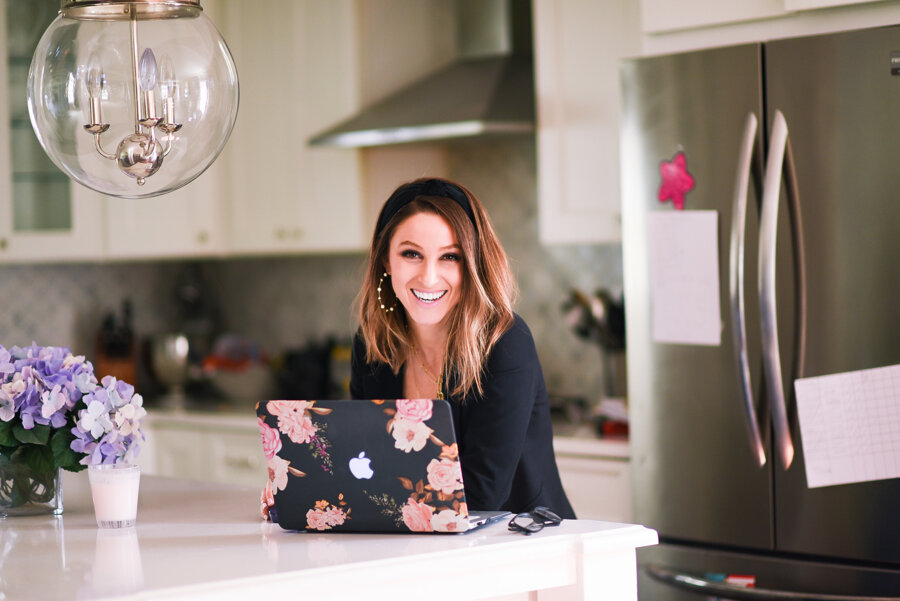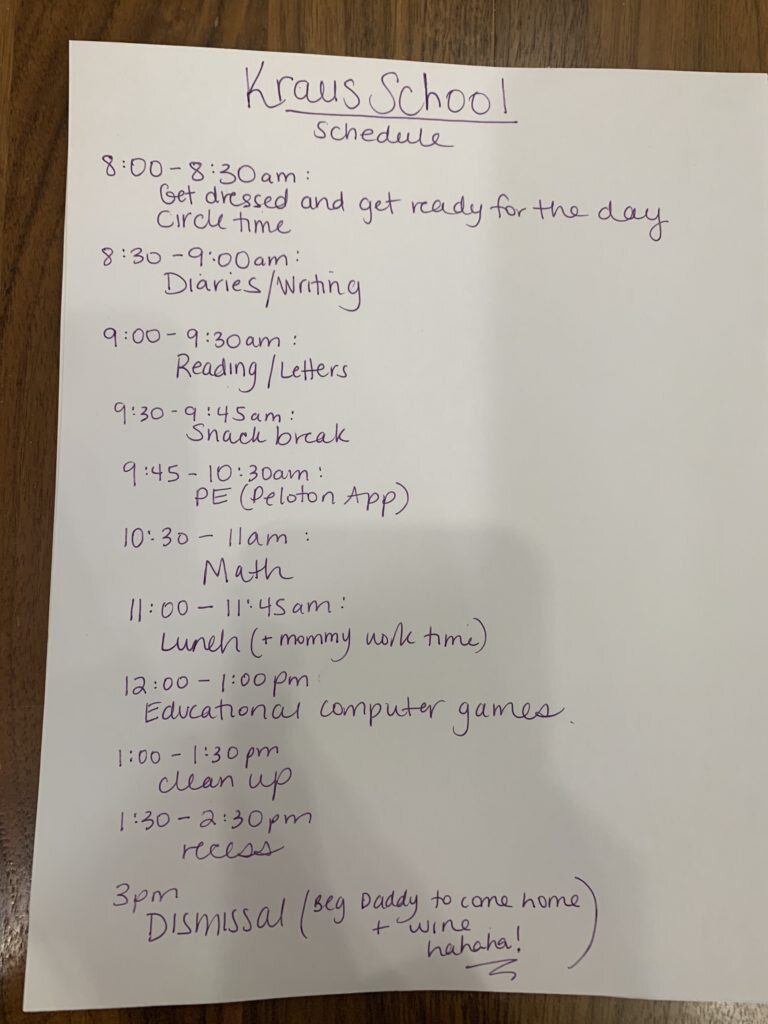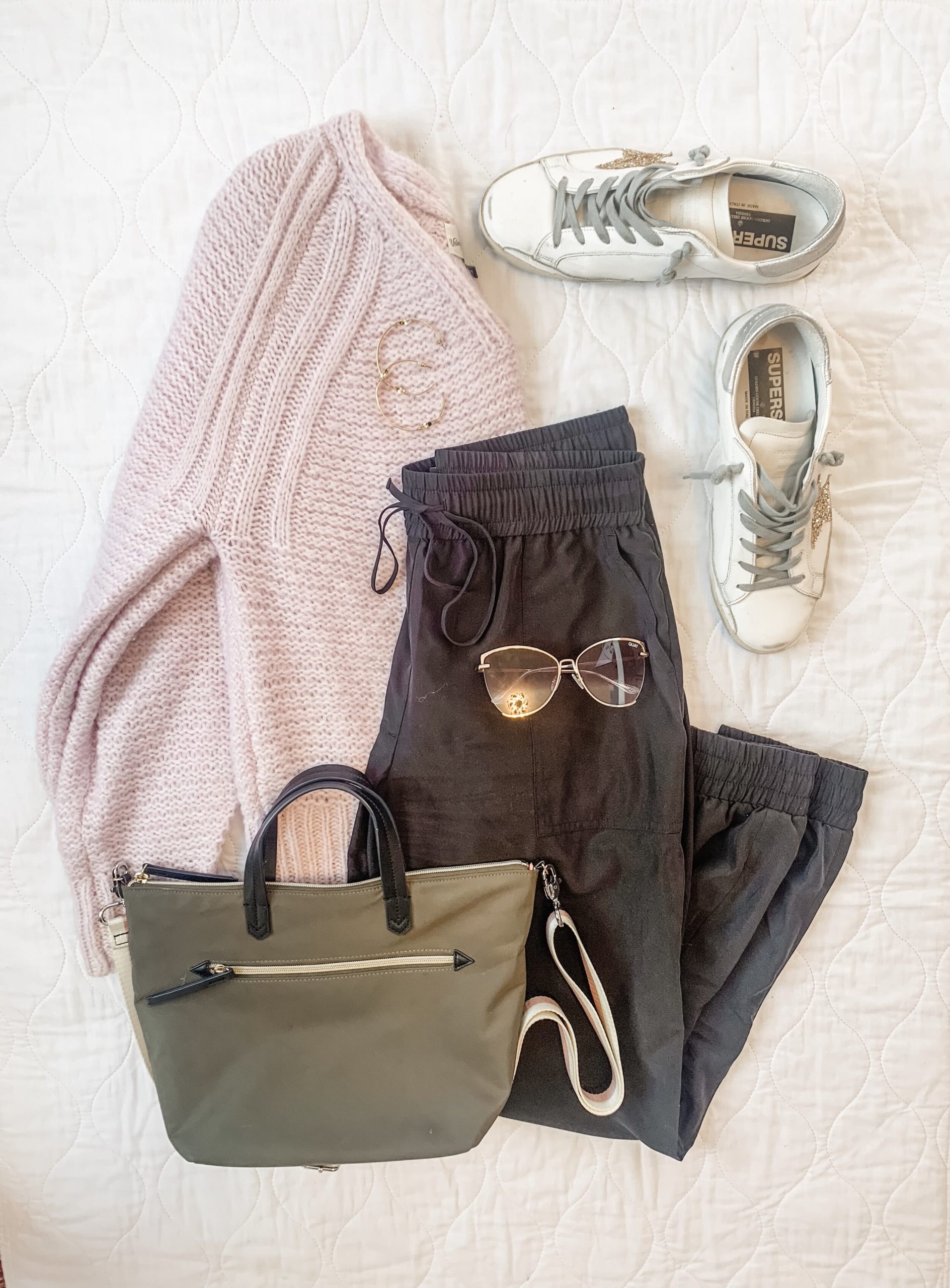
Helloooo roller coaster. Anyone else?
Anyone feeling a little stressed about their newfound profession as a teacher? In addition to your other job – and figuring out how keep everyone healthy, and how you’re going to still work and pay the bills and keep your kids from regressing academically? And also stay sane? And healthy? And keep your anxiety about all of the unknowns at bay? Yeah…. let’s talk.
As a former special education teacher, as a former stay at home mom, and now as a work from home mom (I have a 5 and 6 year old!) running an online fashion business for 5+ years, I’ve worn all the hats and understand the stressors that go along with each one – and that’s WITHOUT a worldwide pandemic.
We have to do all the things at once and figuring out how to do all of it – well – it’s going to be an adjustment for me, for you, for most of us.
So while this is only temporary, it’s real.
I find myself going in and out of freaking out and feeling like this is the best opportunity to really take quality time with my kids, to appreciate TIME in a new way, to connect with people, for some personal development, and to find a new appreciation in every day things that we fall into the habit of taking for granted.
And it’s ok to be up and down. This is all new – and unknown – and the unknown is scary.
But what we CAN do for ourselves and our kids is have a toolbox. A toolbox of tips and strategies for OURSELVES that will benefit our kids – and I’ve done my best to think of all the things that might be helpful right now.
With that said – the “schedule” I posted of our first “homeschooling day” Friday – let’s talk about that. IT IS HELPFUL, YES! But to think we’re all going to stick to it to a tee is simply – well – just in my opinion – it’s unrealistic. So you can breathe a sigh of relief if you’ve never been a teacher before. We’ll talk more about schedule and why it’s important, but we will all DO OUR BEST – because that’s all we can do – and that IS good enough.
Is it amazing to have structure and a plan and some form of consistency for us AND for our kids during this time? YESYESYES. Kids thrive off of consistency – and their “normal” is going to be messed up for a little while, too. So it’s up to us to provide that for them. Which is actually a big weight on us. Which is why we need tools, strategies, all of it. If we’re expected to be strong for them like we have to be, it’s OK to have our own toolbox. That is not weakness. That is strength.
I’ve compiled the tips and resources for at home learning that I hope you find helpful! I’ll update as I get more!
1. Home schooling, in my mind, is not about replicating the school day. Not to say the academics AREN’T important – of course they are. But take it as an opportunity to practice and teach life skills, too. Yes, that includes cleaning. That includes teaching organization. Clean out their rooms/drawers, but let them be part of that decision making process. Clean out the toys. A lesson in de-clutteting and de-emphasizing “things” is extremely important even though not the “traditional” “sit and learn about a topic” type of lesson. Another good one? Cooking! Let them help you make dinner, follow directions, set the table. Give them more responsibility. It’ll make them feel more independent.
2. Schedules are helpful because it offers structure, consistency, a plan, but the schedule can look different every day! My kids LOVED checking off after we did each subject. They’re used to it from school. Go over it with them at the beginning of the day to set expectations and so they know what to expect. Kids like to know what to expect. Post it somewhere they can see it. Let them be a part of checking off what you’ve done. They’ll feel accomplished! But schedule in free time. Schedule in movement time, craft time – things that will be outlets for them, but will also give YOU a little bit of a break. The “classes” that academically are more important for your child – maybe reading, writing, math – try to schedule them in earlier in the day with a snack or movement break inbetween. As the day goes on, the kids will get more tired and you’ll all feel more accomplished checking those things off earlier in the day and you’ll be able to tell them that once they finish, they have “X” to look forward to – crafts, play time – whatever it is. But that this has to be first. I’m going to include a list of resources at the end of this post!
3. Model coping strategies out loud! You’e going to be spending a lot of time with your kids, and even though we want to think it will all be rainbows – the truth of the matter is – we are going to have frustrating moments when we just need a break. TAKE IT! BUT – use it as a teaching moment. MODEL OUT LOUD for your kids HOW and WHY you’re taking a break. “You know, Steven – Mommy is feeling frustrated right now – so I’m going to take a deep breath (model deep breath) and then I’m going to go to my room for 5 minutes – because I know when I take a little break it helps me to feel better!” Maybe set up a little corner with some fidgets (balls, play dough, anything sensory) so they can take a break while you are. Your kids follow your lead way more than we realize. They will use the strategies they see you using. They will. Use those moments as teaching moments. Coping with stress is SUCH an important life skill we can model for and teach them. Talk about feelings in a way that offers them solutions, not in a way that scares them. In a way that teaches them ways to cope.
4. Equally as important, model for them how to laugh. How to keep a sense of humor. This might even be the most important. Smiling is contagious. Happiness is contagious. Find silly songs to sing to make sure they’re washing their hands for long enough. Play freeze dance. Make silly math problems out of the breakfast and lunch you’re giving them. It doesn’t just have to be during the “scheduled” times.
5. You have to find some time to work during the day. How does that fit into the “homeschool schedule?” Well – during the time when the kids are doing an independent activity/learning game, etc., use that time to not only work alongside them, but to EXPLAIN to them that they are going to have to try to figure out the answers to questions on their own if they have them before they automatically ask you. But beyond that- explain WHY. Explain that you also need your time to do your work just like you do when they’re in school – and why that’s important. I think we fall into the trap of telling kids we’re “busy right now” without giving them the explanation. You’re not busy because you’re scrolling the internet, you’re busy because you’re also doing your own work. Whether it seems like it or not, they will start to really understand more about why you work and will respect that the more you explain it. Steven says things like “I’m going to be a work from home dad when I grow up” because he knows that although I am doing it from home, I WORK, and he thinks that’s cool! We talk about the benefits of it all the time, but I also tie it into an explanation about money and why it’s important to have my work time. These are the REAL life lessons.
6. Self care is as important as ever right now. Model self care out loud for your kids. Let them know that it’s important for you to exercise, eat as healthy as possible, drink lots of water, take baths, listen to podcasts, journal, put on a face mask – whatever it is that’s important for you – let THEM know what YOU are doing. They will self care if you do, but it’s something we have to actively teach to them. And write down for yourself the 2-3 things a day you are going to make it a priority to fit in. For me, exercise I NEED right now more than ever. So that’s a definite for me. I’m going to figure out how to fit that in still every day.
7. Get dressed. I know this sounds like a silly one, but think about the feeling you have when you’re in your pajamas all day and the feeling you have when you’re dressed and ready for the day. For me, there’s a clear difference in my productivity, and just my overall attitude. I feel better when I’m dressed. I feel better when I put a little makeup on – even though I’m not going to be seeing anybody. It’s mental for me. But getting ready for the day for us and our kids will keep some sense of normalcy during this time of social isolation.
8. Use video to connect with people!!!! Set up a Zoom with your friends in the evenings! FACETIME! It’ll bring you the social interaction that you crave, even if it’s not in person. Even us introverts need that social connection. This is part of the reason I love social media right now. I love getting on my instastories and connecting with you all because as weird as it is, that helps me to feel “normal” during this time that’s just “abnormal”. Let your friends FaceTime with their friends!
9. Use social media as a happy place. If you find yourself getting anxious because you see so many articles and opinions on facebook, turn it off for a little while. And maybe this is a great time to assess who you follow and if they bring you joy and value. If someone doesn’t, make the choice to unfollow them.
10. Plan. The night before, plan your day. Time block it out. When will you get your work done? When will you get your exercise and self-care in? If you are super focused during that time and not scrolling, chances are you’re way more likely to be able to fit it in. Even if you have to go to bed a little later or wake up a little earlier. It’s only temporary!
I hope this was helpful in any way – and full video on IGTV – my instagram is @juliekrausxo. I’ll do my best to share as much as I can on my Instastories through all of this! WE HAVE GOT THIS! XO
Academic resources for kids of all ages:
Below is a list of virtual resources and at home activities for young children, parents, and caregivers. Early childhood professionals, please free to add anything you think will be useful.Â
**WNET can promote your resources to families via text message** using our Bright by Text service. Here’s what we need for each message:
How to talk about Corornavirus with young childrenKids may have a lot of questions, particularly why we don’t have toys out and programs are different. Here are some resources:
-
-
-
-
-
Brain Pop video for older, school-age children.
-
Library ResourcesÂ
Use your Library Card (New York Public, Brooklyn Public and Queens Public Library) to access the following library resources from your home computer:
-
Bookflix short films about award winning books (English and Spanish Titles)
-
-
-
-
-
Tumble Books
-
-
-
-
-
Ebooks and e-audiobooks are available with your library card.Â
-
-
Don’t have a library card? You can get an e-card here from BPL and Queens (anyone who lives or works in New York State is eligible):
DIY Storytimes– BPL Children’s librarians are curating lists of ebooks, online stories, and ebooks for you offer storytime with your child at home!:
Virtual Storytimes: BPL will offering virtual weekdays at 11:00 (exact schedule TBD) from Friday 3/13 through Tuesday 3/31. Our first one was offered today. You can view it here!Â
Literacy Resources Available Online
Video Read-alouds:
-
KidLit TV Read Out Loud (Authors and illustrators reading their own books!)Â
-
-
Storyline Online (Books read aloud by actors)Â
-
Songs & Rhyme Videos
Here are videos of librarians and others demonstrating songs, rhymes, and fingerplays!Â
-
-
Story Blocks (Colorado Public Libraries)
-
-
Tell Me a Story (King County Library System)
-
At-home Learning Activities
Play Recipes from Brooklyn Public Library: Enjoy these play activities with everyday materials for children 0-3 years.Â
https://www.bklynlibrary.org/event-series/big-brooklyn-playdate
At Home Learning Resources from NYC Department of Education:Â
https://www.schools.nyc.gov/learning/learn-at-home
Public Television ResoucesÂ
Bright By Text: Families can sign up for BBT by texting HERO to 274448 to receive activities to do at home, resources from local organizations, etc.Â
WNET:Our website has curated resources for different topic areas and age groups. As well as a blog with tips on using media with kids, etc.Â
PBS Learning Media: For families and educators looking for more classroom resources, full lesson plans, etc. Learning Media has resources for PreK-12 on a wide range of topics.Â
PBS Parents Blog:Blog posts and information on different topics for early childhood, including how to discuss the virus with young children, as well as hands-on activities you can do from home.
Sesame Street in Communities: Information, videos, coloring sheets, and activities in English and Spanish on a wide range of health, literacy, STEM, and other topics.Â
PBS Kids Apps: Free award-winning apps for children from PBS. Many are in English and Spanish.Â
Fliers for PBSKids App Learning Goals and PBS KIDS Learning Goals
Online Resources from Museums and Other Cultural Institutions
Children’s Museum of the Arts– 52 videos of DIY Activities at Home, How To Videos are less than a minute long, visual instructions, set to music so there is no language barrier.
Resources for Parents of Young Children
INCLUDEnyc as of now are still delivering workshops and you can view their live stream virtually on Early Intervention here: https://www.includenyc.org/resources/includenyc-live/includenyc-live-early-intervention
Literacy Partners
Watch the full telenovela in Spanish,La Fuerza de Creer, on Univision with positive parenting messages. Then talk with your family about ways of seizing time together through reading and activities at home.Â
Please go to greatminds.org/math to find:
-
Student materials such as Problem Sets, Application Problems, and Exit Tickets
-
Homework Helpers
-
Parent Tip Sheets
-
Math card games








